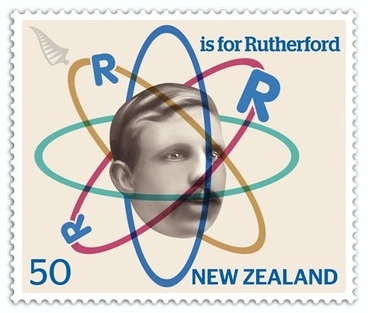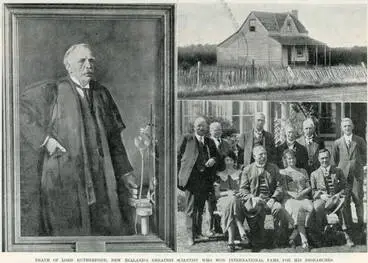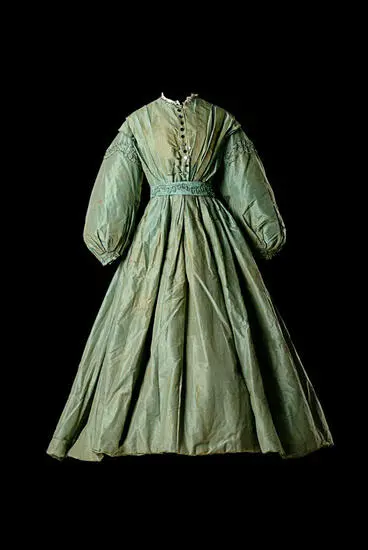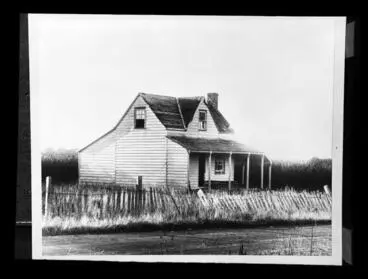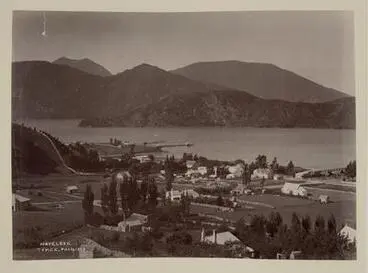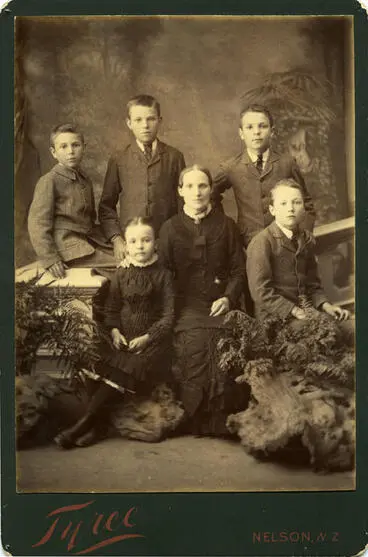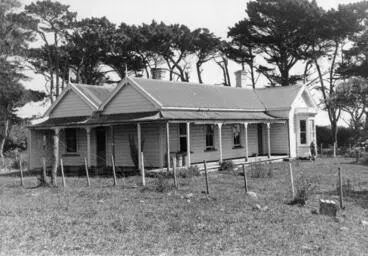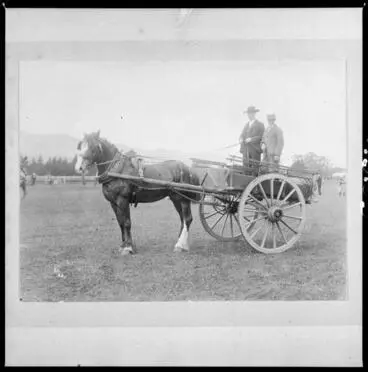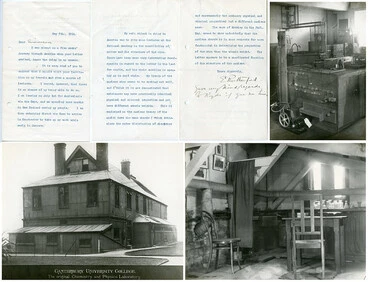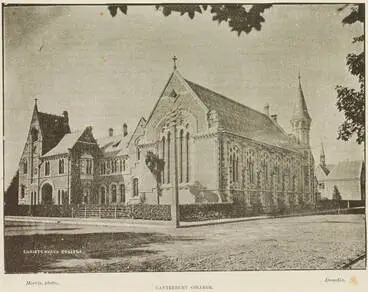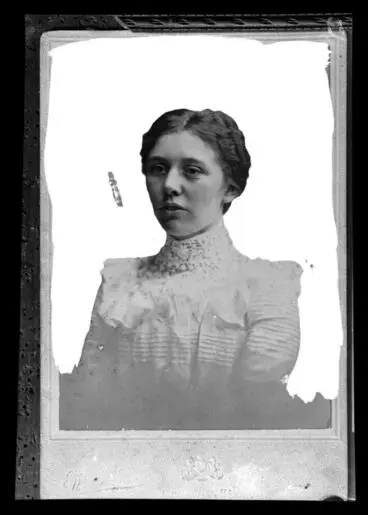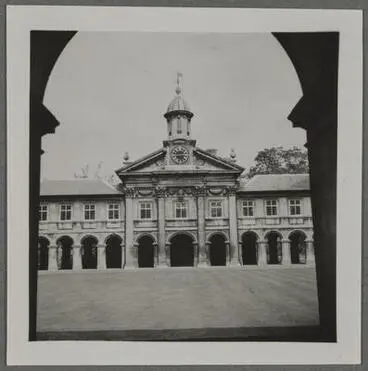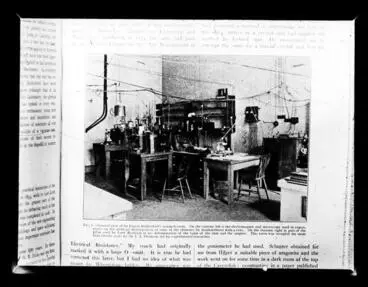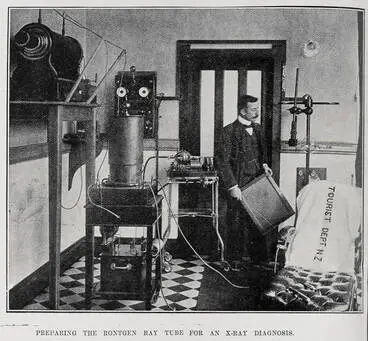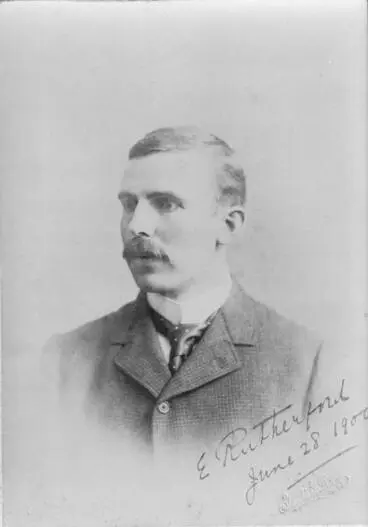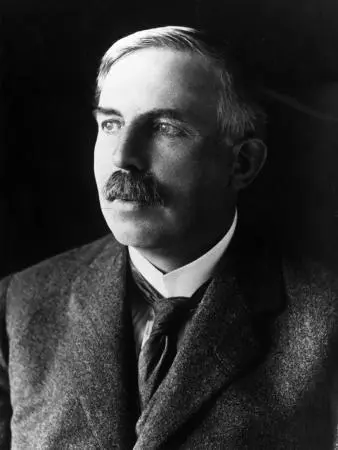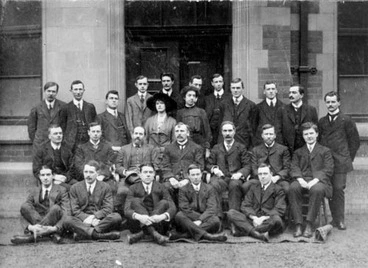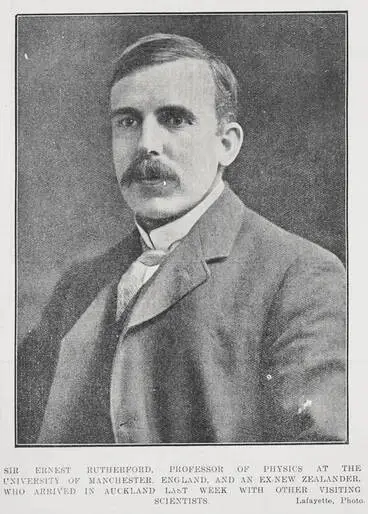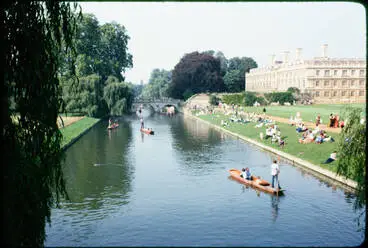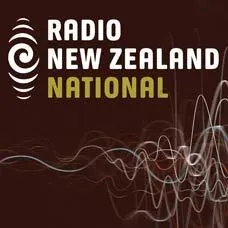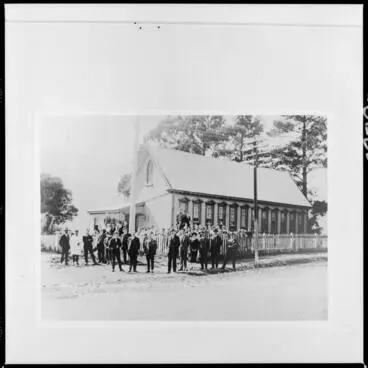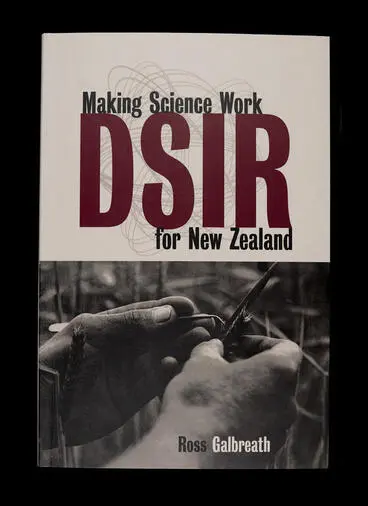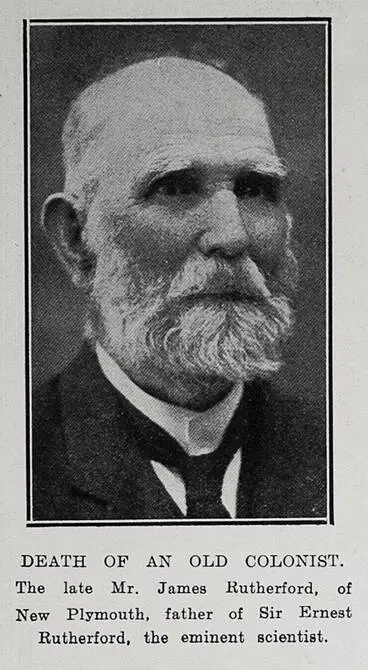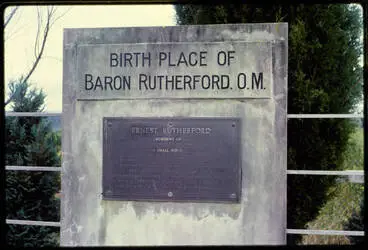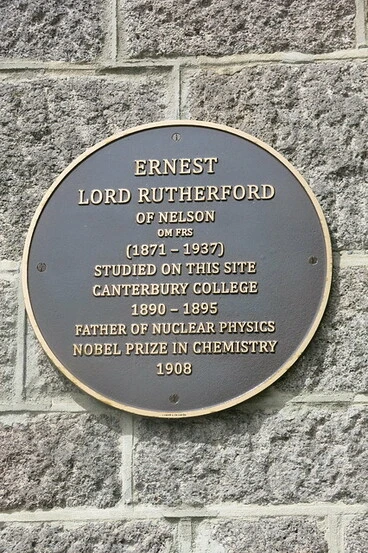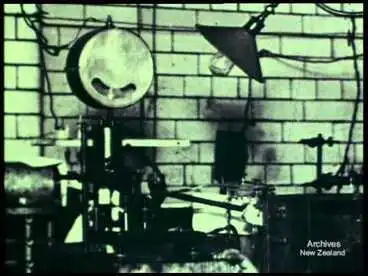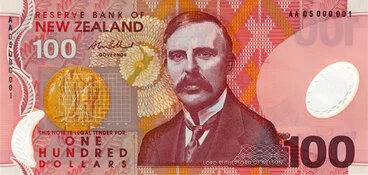Ernest Rutherford - Noble Prize winner, 1908
A DigitalNZ Story by Zokoroa
Ernest Rutherford was the first New Zealander to win a Nobel Prize which he received for Chemistry on 11 December 1908.
Rutherford, Atom, Physics, Physicists, Chemistry, Inventions, Science, Radiation, Nuclear, Nobel Prize
On 11 December 1908, the Nobel Prize in Chemistry was awarded by the Royal Academy of Sciences to Ernest Rutherford, Professor of Physics at the Victoria University, Manchester (England), "for his investigations into the disintegration of the elements, and the chemistry of radioactive substances". These investigations were largely carried out when working at the McGill University in Montreal from 1897 until 1907. See Presentation Speech by Professor K.B. Hasselberg, President of the Royal Academy of Sciences, on 10 December 1908.
Ernest was the first New Zealander to win a Nobel Prize. Two other recipients are Maurice Wilkins for Physiology or Medicine (10 Dec 1962) and Alan MacDiarmid for Chemistry (10 Dec 2000). Ernest was knighted in 1914, decorated with the Order of Merit in 1925 and made a Baron in 1931.
Ernest Rutherford (1871 - 1937)
His early research explored radioactivity & he discovered two distinct types of radiation - alpha & beta
Alexander Turnbull Library
11 Dec 1908: Ernest received the Nobel Prize for Chemistry
Awarded for his investigations into the disintegration of the elements & radioactivity
National Library of New Zealand
Description of the Nobel Prize ceremony held at Stockholm given by Ernest's wife Mary (May) Rutherford
May had attended university at Canterbury College & was the niece of Sir Isaac Newton, the curator of the British Museum
National Library of New Zealand
His research:
Ernest is known as the Father of Nuclear Physics. Albert Einstein said he was the man who "tunnelled into the very material of God". He called him the "Second Newton" after Isaac Newton.
In his early research, Ernest explored radioactivity and he discovered two distinct types of radiation in 1899 which he called alpha and beta. He deduced that almost all the mass of an atom is concentrated in a tiny, dense, positively charged core called a nucleus a thousand times smaller than the atom itself. This led to the nuclear model (also called the planetary model) of the atom being developed with Niels Bohr. The model proposed that circulating around the nucleus are light, negative constituents, called electrons, which revolve similar to planets around the sun. In 1917, Ernest became the first person to create an artificial nuclear reaction by bombarding nitrogen gas with alpha particles. He hypothesised that the penetrating radiation emitted might be the nucleus of a hydrogen atom, which was later identified as a subatomic particle and became known as the proton. Ernest's discovery is now often described as ‘splitting the atom’.
Ernest had claimed that his inventiveness was honed on the challenges of helping out on his parents' farm: ‘We haven't the money, so we've got to think’.
Source: Ernest Rutherford', URL: https://nzhistory.govt.nz/people/ernest-rutherford, (Ministry for Culture and Heritage), updated 28-Jul-2022
In 1899, Ernest discovered two distinct types of radiation which he called alpha & beta
Hughes, Jeffrey (Dr), fl 2011 : Rutherford, radioactivity and the origins of nuclear physics
Alexander Turnbull Library
In 1911, Ernest & Niels Bohr proposed model of an atom having a nucleus around which electrons circulate
Ernest Rutherford stamp
Manatū Taonga, the Ministry for Culture and Heritage
in 1917, Ernest created an artificial nuclear reaction named 'splitting the atom' which occurred in later research
ATOMIC RESEARCH (Evening Post, 11 August 1932)
National Library of New Zealand
His family:
Ernest married Mary (May) Newton (niece of Isaac Newton) in Christchurch in 1900. They had a daughter Eileen in 1901 when living in Montreal. They then moved to England in 1907, and Eileen married mathematician Ralph Fowler in 1921 and had four children. Ernest died in Cambridge, England on 19 October 1937 aged 66 years and his ashes were buried in the nave of Westminster Abbey.
Ernest married Mary (May) Newton in Christchurch in 1900 & had one daughter Eileen. He died on 13 Oct 1937 in England.
Death of Lord Rutherford, New Zealand's greatest scientist who won international fame for his researches
Auckland Libraries
BackStorY
Early years & schooling:
30 Aug 1871: Ernest Rutherford born at Spring Grove (now Brightwater) near Nelson. He was called 'Ern' by his family.
House where Ernest Rutherford was born, and surrounding countryside, Spring Grove, near Nelson
Alexander Turnbull Library
Ernest was the fourth of 12 children to Martha (school teacher) & James Rutherford (wheelwright, engineer & flaxmiller)
Collie, W :[Rutherford family group]
Alexander Turnbull Library
James, a Scotsman, arrived NZ in 1843 as 4 yr old. Martha (neé Thompson) arrived from England in 1855 aged 13.
James and Martha Rutherford
Alexander Turnbull Library
During Taranaki Land War in 1860, Martha evacuated from New Plymouth to Nelson where met James & they married in 1866
MARRIED. (Nelson Evening Mail, 30 April 1866)
National Library of New Zealand
Green silk wedding dress worn by Martha on 28 April 1866 when married James in Spring Grove
Rutherford Dress
Nelson Provincial Museum
Martha became a teacher at the Spring Grove School & received favourable reports from the provincial school inspector
Spring Grove School
Tasman District Libraries
House where Ernest was born & taught by his mother to read & know his multiplication tables to 12 before starting school
Rutherford home
Nelson Provincial Museum
When Ernest was 5, family moved to a farm at Foxhill, where he attended school. He was awarded a class prize in 1878.
Untitled (Colonist, 02 January 1879)
National Library of New Zealand
1882: Family moved to Havelock where father James had established a flaxmill. Baby Percy died of whooping cough in 1883.
Havelock
Auckland Art Gallery Toi o Tāmaki
From 1883-86, Ernest attended Havelock School
Public School, Havelock
Museum of New Zealand Te Papa Tongarewa
1885: Family portrait: Rear, from left: Herbert, Ernest, James; front, from left: Alice, Martha, Charles.
Rutherford family
Puke Ariki
1886: Brothers Herbert & Charles drowned when boating in Marlborough Sounds
THE DROWNING ACCIDENT AT HAVELOCK. (Marlborough Express, 11 January 1886)
National Library of New Zealand
5 Jan 1887: Won Marlborough Education Board scholarship to Nelson College (£40 a year)
THE SCHOLARSHIPS. (Nelson Evening Mail, 05 January 1887)
National Library of New Zealand
From 1887-1889, Ernest attended Nelson College as a boarder
Nelson College, 1888
Nelson Provincial Museum
19 Dec 1887: Received the Stafford scholarship & Classical scholarship, and the Principal's prize for English reading
PRIZE DAY AT THE BOYS' COLLEGE. (Nelson Evening Mail, 19 December 1887)
National Library of New Zealand
27 Dec 1887: Advert to rent family's nine-roomed house at Foxhill, with one acre of land
Page 3 Advertisements Column 2 (Nelson Evening Mail, 27 December 1887)
National Library of New Zealand
24Jan 1888: Advert to sell the house & 34 acres of land, stable, two dairies etc at Foxhill
Page 3 Advertisements Column 2 (Nelson Evening Mail, 24 January 1888)
National Library of New Zealand
On 30 Jan 1888, family moved to New Plymouth & James & two sons set up flaxmill at Pungarehu. (James was still boarding)
Leggatt, T T :[The Rutherford flax mill at Pungarehu] / T T Leggatt Feb 28th 1890
Alexander Turnbull Library
1889: After family villa built near flax mill, Martha & 6 younger children who'd stayed at New Plymouth joined James
Rutherford Homestead, Lower Parihaka Road, Pungarehu
Puke Ariki
As Ernest was still boarding at Nelson College, he would visit during the school holidays
Rutherford, James & Ernest, at Richmond Showgrounds
Nelson Provincial Museum
1889: Nelson College prize-giving: received Simmons Prize, Form VI Classics & Latin, Senior Mathematics. Was head boy.
PRIZE DAY AT THE COLLEGES. GIRLS' COLLEGE. (Nelson Evening Mail, 19 December 1889)
National Library of New Zealand
Attended university at Canterbury College, 1890-1894:
1890: Went to Canterbury College which was one of the four campuses of the University of New Zealand
Gained 3 degrees - BA (1892), MA with 1st class Hons in Phys Science, Maths & Maths Physics (1893) & B.Sc (awarded 1895)
Archives New Zealand Te Rua Mahara o te Kāwanatanga
Ernest's basement den at Canterbury College where he carried out his research
Rutherford's basement 'laboratory', Canterbury College
Manatū Taonga, the Ministry for Culture and Heritage
He rented a room with widowed landlady Mrs Newton & met her daughter Mary (May) who was also the niece of Isaac Newton
Canterbury College
Auckland Libraries
May also attended Canterbury College & met Ernest's family in the holidays. (They were eventually married in 1900.)
Lady Rutherford, nee Mary Newton
Nelson Provincial Museum
1893: Studied high frequency magnetisation of iron & developed timing device to switch circuits under 100,000th of sec
CANTERBURY COLLEGE. (Star, 19 August 1893)
National Library of New Zealand
1894: Delivered a paper on magnetisation of iron at the Philosophical Institute of Canterbury which he'd joined in 1892
Canterbury Philosophical Institute. (Star, 08 November 1894)
National Library of New Zealand
1894: First research paper published on higher frequencies using discharging Leyden jars & a Hertzian oscillator
Art. LIX.— Magnetization of Iron by High-frequency Discharges , Volume 27, 1894, Transactions and Proceedings of the New Zealand Institute, 1894.
Alexander Turnbull Library
Studied at Cambridge University, 1895-1897:
1895: Received the '1851 Research Fellowship' and studied at the Cavendish Laboratory of the University of Cambridge
Cambridge University
Auckland War Memorial Museum Tāmaki Paenga Hira
c.1895: Ernest included in a group photo. J.J. (John Joseph) Thomson led the Cavendish Laboratory since 1884.
Messrs Stearn (Photographers) : Group from the University of Cambridge
Alexander Turnbull Library
Ernest's research room where he measured high frequency dielectric properties of materials using his magnetic detector
Lord Rutherford
Nelson Provincial Museum
During 1895, in his research at the Cavendish Laboratory, Ernest carried out experiments on how an oscillatory discharge would magnetize iron.
"Besides showing that an oscillatory discharge would magnetize iron, which happened already to be known, Rutherford determined that a magnetized needle lost some of its magnetization in a magnetic field produced by an alternating current. This made the needle a detector of electromagnetic waves, a phenomenon that had only recently been discovered. In 1864 the Scottish physicist James Clerk Maxwell had predicted the existence of such waves, and between 1885 and 1889 the German physicist Heinrich Hertz had detected them in experiments in his laboratory. Rutherford’s apparatus for detecting electromagnetic waves, or radio waves, was simpler and had commercial potential. He spent the next year in the Cavendish Laboratory increasing the range and sensitivity of his device, which could receive signals from half a mile away. However, Rutherford lacked the intercontinental vision and entrepreneurial skills of the Italian inventor Guglielmo Marconi, who invented the wirelesstelegraph in 1896."
Source: Britannica: Ernest Rutherford - British physicist, https://www.britannica.com/biography/Ernest-Rutherford
Ernest's Fellowship was renewed in 1896 & then extended for a further year for 1897
NEW ZEALANDERS' SCHOLARSHIPS EXTENDED. (Evening Post, 03 August 1897)
National Library of New Zealand
Ernest studied Hertzian or radio waves & succeeded in transmitting a signal a mile away in Feb 1896
A Young New Zealander at Home. (Poverty Bay Herald, 10 June 1896)
National Library of New Zealand
During 1895. radio waves were also being investigated by Marconi who invented the wireless telegraph in 1896
SIGNOB MARCONI AND HIS INSTRUMENT (Auckland Star, 15 July 1899)
National Library of New Zealand
During 1895, x-rays were discovered by German physicist Wilhelm Conrad Rontgen. This led to J.J. Thomson and Rutherford collaborating on how x-rays changed the conductivity of gases.
They looked at "ionization—the breaking of atoms or molecules into positive and negative parts (ions)—and the charged particles’ attraction to electrodes of the opposite polarity. Thomson then studied the charge-to-mass ratio of the most common ion, which later was called the electron, while Rutherford pursued other radiations that produced ions. Rutherford first looked at ultraviolet radiation and then at radiation emitted by uranium. (Uranium radiation was first detected in 1896 by the French physicist Henri Becquerel.) Placement of uranium near thin foils revealed to Rutherford that the radiation was more complex than previously thought: one type was easily absorbed or blocked by a very thin foil, but another type often penetrated the same thin foils. He named these radiation types alpha and beta, respectively, for simplicity. (It was later determined that the alpha particle is the same as the nucleus of an ordinary helium atom—consisting of two protons and two neutrons—and the beta particle is the same as an electron or its positive version, a positron.) "
In 1897, J.J. Thomson announced the discovery of the electron, the first object lighter than an atom.
Source: Ibid
1896: Ernest & J.J. Thomson looked at how x-rays (discovered by Wilhelm Rontgen in 1895) changed conductivity of gases
Preparing The Rontgen Ray Tube For An X-Ray Diagnosis
Auckland Libraries
1897: Ernest receives Cambridge's first B.A.(by research). His father James opened a new flax mill at Opunake.
[Rutherford's flax mill, Opunake]
Alexander Turnbull Library
Professorship at McGill University, Montreal, 1898-1907:
In 1898, Ernest accepted a professorship at McGill University, Montreal
CABLE NEWS. [BY ELECTRIC TELEGRAPH.—COPYRIGHT.] (Evening Post, 06 August 1898)
National Library of New Zealand
After arriving at the McGill University in Montreal, Ernest teamed up with colleague Frederick Soddy (a demonstrator at McGill) to explore radioactivity. They developed the transformation theory, or disintegration theory, to explain radioactivity. They "claimed that the energy of radioactivity came from within the atom, and the spontaneous emission of an alpha or beta particle signified a chemical change from one element into another. " An alpha particle (or beta ray) is formed by two protons and two neutrons being bound together, whereas a beta particle (or beta ray) is a high-energy electron. "Rutherford considered the alpha particle, because it had a tangible mass, to be the key to transformations. He determined that it carried a positive charge, but he could not distinguish whether it was a hydrogen or helium ion."
Source: Ibid
1898: Ernest & colleague Frederick Soddy found 2 types of emissions come from radioactive atoms - alpha & beta rays
Radioactivity. (Progress, 01 November 1905)
National Library of New Zealand
In 1899, Ernest discovered a radioactive gas (later named radon) which he discussed at British Assoc. meeting in 1903
The Wonders of Radium. (Wanganui Chronicle, 26 November 1903)
National Library of New Zealand
1900: Elected a fellow of the Royal Society of Canada, & awarded MSc from McGill University
Rutherford, Ernest
Nelson Provincial Museum
Married Mary (May) Newton, 1900:
In 1900, Ernest visited NZ to marry May in Christchurch on 28 June. (Being employed, he could now provide for them.)
MARRIAGE. (Taranaki Herald, 09 July 1900)
National Library of New Zealand
Ernest & May returned to Montreal & their only child, Eileen Mary, was born on 20 March 1901
Ernest Rutherford and Mary Georgina Rutherford
Alexander Turnbull Library
1901: Awarded D.Sc. by the New Zealand University. Now known as Dr Rutherford.
Ernest Rutherford
Manatū Taonga, the Ministry for Culture and Heritage
In 1903, Ernest discovered radium emits 'massive, positively charged particles, which are probably atoms'
A CLEVER NEW ZEALANDER. (Hawera & Normanby Star, 06 June 1903)
National Library of New Zealand
1903: Elected Fellow of the Royal Society of London for his investigations into radioactivity
PROFESSOR RUTHERFORD. (Wairarapa Daily Times, 20 June 1903)
National Library of New Zealand
19 May 1904: Ernest delivered Bakerian lecture "The succession of changes in radio-active bodies" to the London Society
Personal. (Taranaki Herald, 11 May 1904)
National Library of New Zealand
1904: As lead was the final decay product of uranium, Ernest proposed rate of decay would allow minerals to be dated
ORIGIN OF RADIUM. (Clutha Leader 20-9-1904)
National Library of New Zealand
1904: Awarded Rumford medal for discovery of the existence & properties of gaseous emanations from radio-active bodies
SCIENTIFIC RESEARCH. (Evening Post, 12 November 1904)
National Library of New Zealand
1905: Ernest delivered a lecture on 'Radioactive transformations" at Silliman Memorial Lectures held at Yale University
THE SILLIMAN LECTURES. (Marlborough Express, 14 January 1905)
National Library of New Zealand
1905: Ernest published 2nd edition of his work on "Radio-activity"
A DISTINGUISHED HEW ZEALANDER (Wanganui Herald, 07 June 1905)
National Library of New Zealand
1906: Awarded LL.D. by Universities of Pennsylvania & Wisconsin. (Photo: Ernest & colleagues at McGill Univ, 1906)
McGill Physics Building, Montreal 1906
Alexander Turnbull Library
Professorship at Manchester University, 1907-1919:
1907: Accepted role of Professor of Physics at Manchester University. Was awarded LL.D by McGill University.
A BRILLIANT SCIENTIST. (Taranaki Daily News 2-4-1907)
National Library of New Zealand
1908: Ernest gave a lecture at the Royal Institution on "Recent Researches on Radio-Activity"
PARENTS OF RADIUM. (Evening Post, 18 March 1908)
National Library of New Zealand
1908: Ernest (R) & Hans Geiger developed electrical method of detecting single particles emitted by radioactive atoms
Ernest Rutherford and Hans Geiger, physics laboratory, Manchester University, England
Alexander Turnbull Library
Replica of Rutherford & Geiger electrical detector of single ionizing particles which Geiger perfected as Geiger counter
Replica of Rutherford and Geiger apparatus for determining the charge on the alph-particle, after original Cavendish Lab apparatus of 1908
Digital Public Library of America
March 1908: The Turin Academy of Science awarded Ernest the Bresa Prize for radioactive work
HONOUR FOR AN EX-NEW ZEALANDER (Otago Daily Times 23-3-1908)
National Library of New Zealand
Nov 1908: Update from Ernest sent to Scientific Weekly on his work on atomic disintegration
PROFESSOR RUTHERFORD'S WORK. (Mataura Ensign 29-12-1908)
National Library of New Zealand
11 Dec 1908: Nobel Prize for chemistry for his investigations into the disintegration of the elements & radioactivity
Rutherford wins Nobel Prize
Manatū Taonga, the Ministry for Culture and Heritage
Jan 1909: Update on Ernest's work showed an alpha particle, when its charge is neutralised, is a helium atom
PROFESSOR RUTHERFORD'S WORK. (Marlborough Express, 04 January 1909)
National Library of New Zealand
1910: Ernest is seated, centre of middle row, with staff from Manchester University physical & electro-technical labs
Manchester University physical and electro-technical laboratories staff, 1910
Manatū Taonga, the Ministry for Culture and Heritage
1910: Ernest (seated 4th on right) with colleagues. That same year, his sister Alice Elliott died on 5 Aug
Ernest Rutherford and members of the Manchester University physical and electro-technical laboratories staff
Alexander Turnbull Library
1910: Ernest wrote the entry on radioactivity for the 11th edition (1910) of the Encyclopædia Britannica
ENCLYCLOPAEDIA BRITANNICA. (Wanganui Chronicle, 02 September 1910)
National Library of New Zealand
30 Oct - 3 Nov 1911: Attended 1st Solvay Conference in Brussels, Belgium. (Standing 4th from right)
Group at the 1st Solvay Conference on physics, Brussels, Belgium - Photograph taken by Benjamin Couprie
Alexander Turnbull Library
1914: Ernest and other scientists visited NZ after attending the Science Congress held in Australia
Sir Ernest Rutherford, Professor of Physics at the University of Manchester, England, and an ex-New Zealander, who arrived in Auckland last week wi...
Auckland Libraries
6 Sept 1914: Gave lecture at Wellington Town Hall on "The Transformation of matter and the structure of the atom"
MARVELS OF MATTER (Otago Daily Times 7-9-1914)
National Library of New Zealand
In 1917, Ernest split the atom by changing nitrogen into hydrogen & published his research in 1919
THE MIGHTY ATOM." (Poverty Bay Herald, 15 June 1920)
National Library of New Zealand
WWI: Ernest on the Imperial Board of Munitions set up by the British Govt & assisted US with submarine & other services
A DISTINGUISHED NEW ZEALANDER. (Wanganui Chronicle, 15 April 1919)
National Library of New Zealand
During WWI, Ernest & Prof W. H. Bragg involved in research on acoustic methods of detecting submarines
SCIENCE IN WAR. (Northern Advocate, 01 July 1919)
National Library of New Zealand
1919: Ernest dissolved the element nitrogen into two other known elements, helium & hydrogen
NITROGEN A COMPOUND (Otago Daily Times 2-8-1919)
National Library of New Zealand
Professorship at Cambridge University, 1919
April 1919: Ernest appointed Professor of Experimental Physics & Director of Cavendish Laboratories at Cambridge Univ
SIR ERNEST RUTHERFORD. (Taranaki Daily News 15-4-1919)
National Library of New Zealand
Bought a cottage across the River Cam from Cavendish Lab. Daughter Eileen married mathematician Ralph Fowler in 1921.
Punting, Cambridge, 1979
Auckland Libraries
Sept 1920: Gave 3 lectures at Copenhagen University on atoms and isotropes, & received degree of Doctor Honoris Causa
SIR ERNEST RUTHERFORD (Evening Post, 16 November 1920)
National Library of New Zealand
1921: During a debate in Britain, Ernest was in favour of women receiving the same privileges & rights as men at College
Untitled (NZ Truth, 12 March 1921)
National Library of New Zealand
1922: Ernest became President of the British Association for the Advancement of Science following his nomination
SIR ERNEST RUTHERFORD (Evening Post, 22 March 1922)
National Library of New Zealand
1922: Elected Corresponding Member of the Russian Academy of Science & elected Honorary Member in 1925
Ernest Rutherford and The Russian Connection
Radio New Zealand
Nov 1922: The Royal Society of London awarded the Copley Medal for Ernest's research in radioactivity & atomic structure
SIR ERNEST RUTHERFORD (Evening Post, 10 November 1922)
National Library of New Zealand
Nov 1923: Evening Post reports Sir Rutherford to speak at the British Association Congress & extols his experiments
SIR E. RUTHERFORD (Evening Post, 06 November 1923)
National Library of New Zealand
1920s: Elected an Honorary Fellow of the Royal College of Physicians
Famous New Zealander Honoured: Sir Ernest Rutherford
Auckland Libraries
1924: Franklin medal & Certificate from Franklin Institute, Philadelphia, was presented for radioactivity discovery
SIR E. RUTHERFORD (Evening Post, 13 September 1924)
National Library of New Zealand
1925: In New Year's Honours the Order of Merit was conferred on Sir Ernest Rutherford
NEW YEAR HONOURS (Evening Post, 02 January 1925)
National Library of New Zealand
29 Oct 1925: Sir Ernest Rutherford visited his old school at Havelock
Prof. Sir Ernest Rutherford visits his old school at Havelock
Nelson Provincial Museum
Ernest photographed outside the school fence, Havelock
King, June, fl 1975: Photograph of Ernest Rutherford outside the school fence, Havelock - Photograph taken by Claude Mills
Alexander Turnbull Library
During his NZ visit, Ernest lectured on the atom & its structure. He also advocated Govt support education & research.
Richardson, Harry Linley, 1878-1947 :Sir Ernest Rutherford lecturing on the atom, Town Hall Wellington, 1925.
Alexander Turnbull Library
Nov 1925: Degree of Honorary Doctor was conferred on Ernest at the Sorbonne
SORBONNE DEGREES (Evening Post, 09 January 1926)
National Library of New Zealand
In 1926, the New Zealand DSIR was formed. Ernest becomes Chairman of the Advisory Council from 1929-37.
DSIR :making science work for New Zealand : themes from the history of the Department of Scientific and Industrial Research, 1926-1992 /
MOTAT
1925-1930: Ernest was President of the Royal Society of London
SIR ERNEST RUTHERFORD (Evening Post, 02 December 1925)
National Library of New Zealand
23 May 1926: Ernest's father James passed away
Death of an Old Colonist: The late Mr. James Rutherford
Auckland Libraries
Obituary for James Rutherford
A SCIENTIST'S FATHER (Evening Post, 25 May 1928)
National Library of New Zealand
1930: Ernest awarded the Faraday Medal for electrical science research
SIR ERNEST "RUTHERFORD, a famous New Zealander, who has been awarded the Faraday Medal for electrical science research^ (Evening Post, 28 January 1...
National Library of New Zealand
24 Dec 1930: Daughter Eileen Fowler died of a blood clot, 9 days after birth of fourth child (had 2 sons & 2 daughters)
PERSONAL NOTES (Evening Post, 29 December 1930)
National Library of New Zealand
Jan 1931: Awarded Honorary Doctorate of Science from the University of New Zealand which was their first honorary degree
NEW DEPARTURE (Evening Post, 19 January 1931)
National Library of New Zealand
1931: Made a Baron. Coat of arms: kiwi, Māori warrior, & Hermes Trismegistus - patron saint of knowledge & alchemists
RUTHERFORD, Sir Ernest (Baron Rutherford of Nelson, O.M., F.R.S.)
Manatū Taonga, the Ministry for Culture and Heritage
1931-33: President of the Institute of Physics which was inaugurated in 1920 & first met on 27 April 1921
THE BRITISH INSTITUTE OF PHYSICS. (Ohinemuri Gazette, 05 September 1921)
National Library of New Zealand
1932: Ernest with group of scientists in Munster, Germany
[Group including Sir Ernest Rutherford]
Alexander Turnbull Library
1932: Further experiments on splitting the atom carried out by Dr. E. T. Walton, Lord Rutherford, & Dr. J. D. Cockroft
THE MEN WHO SPLIT THE ATOM.-/W left, Dr. E. T. Walton, Lord Rutherford, and Dr. J. D. Cockroft, who recently carried -out valuable .experiments at'...
National Library of New Zealand
In 1932, Ernest's colleagues Cockcroft & Chadwick discovered the neutron
MODERN ADVANCE (Evening Post, 17 June 1935)
National Library of New Zealand
Chadwick found a new projectile & Cockcroft & Walton showed how nuclei of atoms could be disintegrated (split the atom)
WORK IN PHYSICS (Evening Post, 26 November 1935)
National Library of New Zealand
3 Dec 1932: Ernest announced theory that gamma rays arose from the motions of alpha particles in the nucleus
GAMMA RAYS (Evening Post, 04 February 1932)
National Library of New Zealand
1933-37: President of the Academic Assistance Council - helped German scientists & scholars displaced by Hitler
LONDON PERSONALS (Evening Post, 19 July 1933)
National Library of New Zealand
1934: Ernest & Mark Oliphant discover H3 (tritium) & He3 (helium). (RNZ interview with author Andrew Ramsay, 2019)
The unlikely partnership that unlocked the atom
Radio New Zealand
Aug 1934: Lord Rutherford (left) & High Commissioner for NZ Sir James Parr sampling millionth case of Nelson apples
Sport and General" Photo. THE MILLIONTH CASE.—Lord Rutherford (left) and'the High Commissioner for New Zealand, Sir James Parr, sampling the millio...
National Library of New Zealand
1934: Portrait of Ernest Rutherford, his left hand on a pile of books & a retort to his left. Painted by Oswald Birley.
Birley, Oswald Hornby Joseph, 1880-1952 :[Lord Rutherford of Nelson] 1934
Alexander Turnbull Library
16 July 1935: Ernest's mother May (born 29 Oct 1842) passed away aged 92 years
MRS. M. RUTHERFORD (Evening Post, 17 July 1935)
National Library of New Zealand
10 Dec 1935: Opened new L.M.S. Research Laboratories at Derby for research on maintenance & upkeep of railway services
Sport and General" Photo. SCIENCE AND INDUSTRY.—Lord Rutherford of Nelson opened the new L.M.S. Research Laboratories at Derby on December 10, whe...
National Library of New Zealand
Ernest Rutherford, 1st Baron Rutherford of Nelson, passed away in 1937:
Ernest died aged 66 years in Cambridge, England on 19 October 1937, due to complications with a hernia. His ashes were interred in the nave of Westminster Abbey near Sir Isaac Newton.
Lady Rutherford retired to Christchurch, where she died in 1954.
19 Oct 1937, Ernest died in Cambridge at the age of 66, & was buried in the nave at Westminster Abbey
Lord Rutherford grave, Westminster Abbey
Nelson Provincial Museum
When JJ Thomson died in 1940 he was interred next to Ernest.
During the First World War, Ernest "had expressed the hope that no one would discover how to extract the energy of the atom until man was ‘living at peace with his neighbours’. Nuclear fission, which made possible the use of nuclear power, was discovered two years after his death."
Source: 'Ernest Rutherford', URL: https://nzhistory.govt.nz/people/ernest-rutherford, (Ministry for Culture and Heritage), updated 28-Jul-2022
Accolades
Ernest Rutherford was knighted in 1914, decorated with the Order of Merit in 1925, and made a Baron in 1931. He received a number of other awards over the years, including Honorary Doctor at the Universities of New Zealand, Oxford, Edinburgh, Dublin, Durham, Birmingham, Liverpool, Yale, Wisconsin, Philadelphia, McGill, Toronto, Clark, Melbourne, Giessen, and Copenhagen; and an honorary D.Phil. from Goettingen University. Following the death of his wife, Ernest's scientific medals were given to the University of Canterbury.
List of honours & awards received by Ernest, published 1966
: Rutherford's Chief Honours and Scholastic Distinctions
Manatū Taonga, the Ministry for Culture and Heritage
For an additional list of awards, institutions, buildings, streets, other places, items etc named after Rutherford, see: Wikipedia: Ernest Rutherford, https://en.wikipedia.org/wiki/Ernest_Rutherford
Plaque at Brightwater marking the birthplace of Ernest Rutherford
Rutherford birthplace plaque, 1967
Auckland Libraries
The memorial to Ernest Rutherford at Brightwater features a statue of him as a young boy
Ernest Rutherford memorial, Brightwater
Manatū Taonga, the Ministry for Culture and Heritage
Memorial wall at Havelock dedicated to NZ scientists Ernest Rutherford & William Pickering opened in 2003
Rutherford - Pickering memorial, Havelock
Manatū Taonga, the Ministry for Culture and Heritage
Ernest Rutherford plaque at University of Canterbury (formerly Canterbury College)
Ernest Rutherford plaque - Arts Centre
Christchurch City Libraries
Aug 1971: Ernest Rutherford Centenary of Birth Medal by the Franklin Mint, United States
Ernest Rutherford Centenary of Birth Medal
Museum of New Zealand Te Papa Tongarewa
1972: Video (18.06 min): 'Rutherford of Nelson' traces his life and work, & continuing contact with NZ
Rutherford of Nelson (1972)
Archives New Zealand Te Rua Mahara o te Kāwanatanga
1992: Ernest's image began to appear on the $100 note. His image also appeared on a stamp issued by NZ Post.in 2008.
Fifth series of banknotes: $100
Manatū Taonga, the Ministry for Culture and Heritage
2018: RNZ Audio (13.33min): Science Story - The legacy of Ernest Rutherford
Science Story - The legacy of Ernest Rutherford
Radio New Zealand
2018: Interview with great granddaughter Dr Mary Fowler who opened Rutherford Regional Science and Innovation Centre
Ernest Lord Rutherford's progeny Mary Fowler
Radio New Zealand
Find out more:
AIP: Rutherford's nuclear family, https://history.aip.org/exhibits/rutherford/sections/rutherfords-nuclear-family.html
Britannica: Ernest Rutherford, https://www.britannica.com/biography/Ernest-Rutherford
'Ernest Rutherford', URL: https://nzhistory.govt.nz/people/ernest-rutherford, (Ministry for Culture and Heritage), updated 28-Jul-2022
John Campbell. 'Rutherford, Ernest', Dictionary of New Zealand Biography, first published in 1996, updated January, 2002. Te Ara - the Encyclopedia of New Zealand, https://teara.govt.nz/en/biographies/3r37/rutherford-ernest
Rutherford.org.nz - Milestones: http://www.rutherford.org.nz/milestones.htm
Wikipedia: Ernest Rutherford, https://en.wikipedia.org/wiki/Ernest_Rutherford
